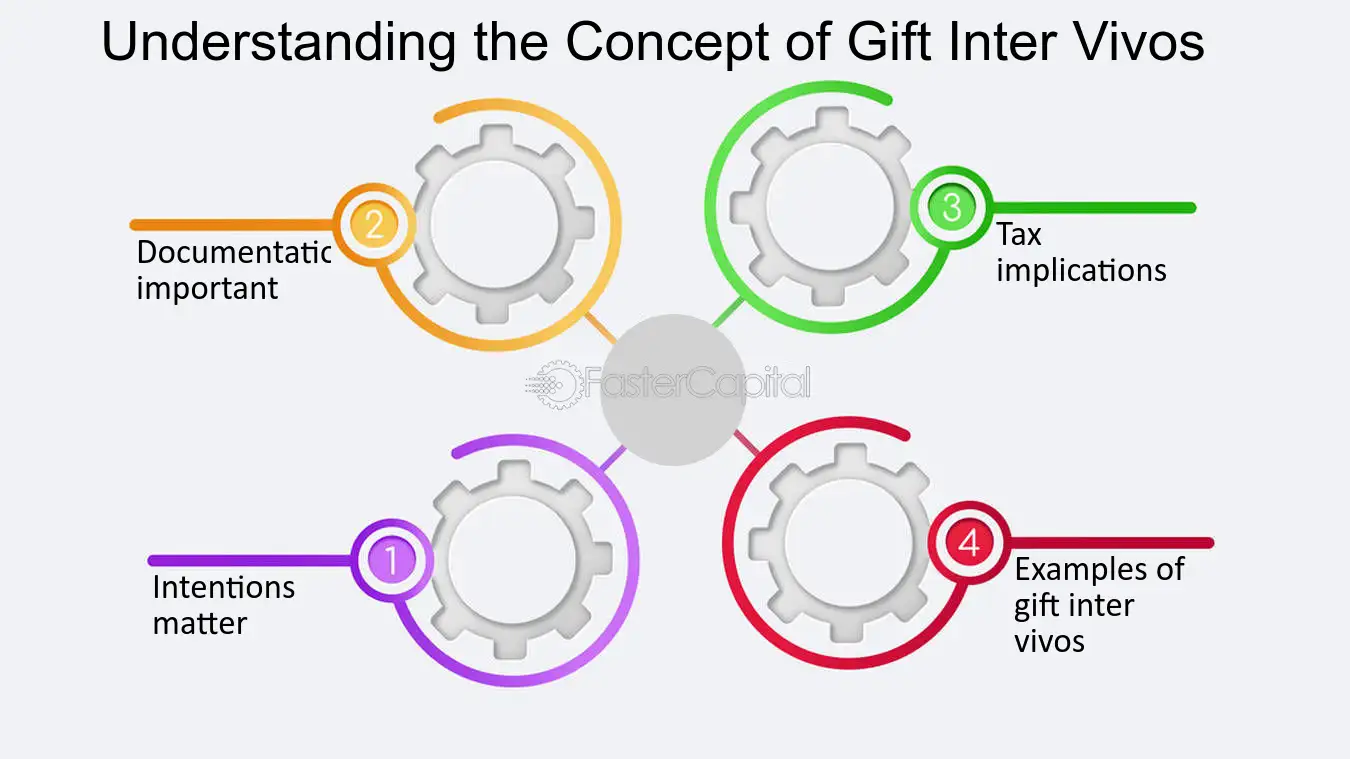Gift Inter Vivos: Definition

Process of Gift Inter Vivos
The process of making a gift inter vivos typically involves the following steps:
- Intent: The donor must have the intention to make a gift and transfer ownership of the asset to the donee.
- Delivery: The donor must physically or symbolically deliver the asset to the donee. This can be done through various means, such as handing over the keys to a car or signing a document transferring ownership.
- Acceptance: The donee must accept the gift. Acceptance can be expressed or implied, but it is essential to establish that the donee is willing to receive the gift.
Once these steps are completed, the gift inter vivos is considered legally valid and the ownership of the asset is transferred to the donee. It is important to note that a gift inter vivos is irrevocable, meaning it cannot be revoked or canceled by the donor unless there are specific circumstances outlined in the legal documentation.
Example of Gift Inter Vivos
Let’s consider an example to better understand gift inter vivos. John wants to gift his vacation home to his daughter, Sarah, while he is still alive. John expresses his intention to make the gift and signs a deed transferring ownership of the vacation home to Sarah. He then physically hands over the signed deed to Sarah, who accepts the gift. The gift inter vivos is complete, and Sarah becomes the legal owner of the vacation home.
Gift inter vivos can be a valuable tool in trust and estate planning. It allows individuals to transfer assets to their loved ones during their lifetime, reducing the size of their estate and potentially minimizing estate taxes. However, it is crucial to consult with an experienced attorney or financial advisor to ensure that the gift inter vivos is properly executed and aligned with your overall estate planning goals.
The process of making a gift inter vivos begins with the donor’s intention to transfer ownership of a specific asset or property to another individual. The donor must have the legal capacity to make such a gift and must do so willingly, without any coercion or duress. It is important to note that once the gift is made, the donor loses all control and ownership rights over the transferred asset.
In trust and estate planning, gift inter vivos serves several important purposes. Firstly, it allows individuals to transfer their assets and property to their loved ones or beneficiaries while they are still alive. This can help avoid complications and disputes that may arise after the donor’s death, ensuring a smooth transfer of ownership.
Additionally, making a gift inter vivos can have significant tax benefits. By transferring assets during their lifetime, donors can reduce the overall value of their estate, potentially minimizing estate taxes. However, it is essential to consult with a tax professional or an estate planning attorney to understand the specific tax implications and requirements.
Furthermore, gift inter vivos can be used as a strategy to protect assets from creditors. By transferring assets to another person, donors can shield them from potential legal claims or financial difficulties. However, it is important to note that fraudulent transfers made to avoid creditors can be challenged and invalidated.
When considering gift inter vivos as part of trust and estate planning, it is crucial to carefully document the transfer. This documentation should include a written agreement or deed of gift, clearly stating the donor’s intention, the recipient’s acceptance, and the details of the transferred asset. It is advisable to consult with an attorney to ensure the legal validity and enforceability of the gift.
Gift Inter Vivos: Process and Example

The process of making a gift inter vivos involves several steps. First, the donor must decide what assets they want to gift and determine the value of those assets. It is important for the donor to consult with a financial advisor or attorney to ensure that the gift is structured properly and complies with applicable laws.
Once the donor has identified the assets to be gifted, they must formally transfer ownership of those assets to the recipient. This can be done through various methods, such as signing over the title of a property or transferring funds from one bank account to another. It is crucial that the transfer is properly documented to avoid any disputes or legal issues in the future.
It is also important for the donor to consider any tax implications of making a gift inter vivos. In some cases, the donor may be required to pay gift taxes on the value of the assets being transferred. Consulting with a tax professional can help ensure that the donor is aware of any potential tax consequences and can plan accordingly.
Here is an example to illustrate the process of making a gift inter vivos:
John wants to gift his vacation home to his daughter, Sarah, while he is still alive. He consults with his attorney to ensure that the gift is structured properly and complies with all legal requirements. John determines the value of the vacation home and prepares the necessary documentation to transfer ownership to Sarah.
John and Sarah meet with a notary public to sign the necessary documents, including a deed transferring ownership of the vacation home to Sarah. The notary public witnesses the signing and notarizes the documents to make them legally binding.
After the transfer is complete, John is no longer the owner of the vacation home. Sarah now has full ownership and can use, sell, or otherwise dispose of the property as she sees fit.
Exploring the Steps Involved in Making a Gift Inter Vivos and a Real-life Example

Making a gift inter vivos, or a gift made during one’s lifetime, is a common practice in trust and estate planning. It allows individuals to transfer assets to their loved ones while they are still alive, providing them with financial support and potentially reducing the size of their taxable estate.
Step 1: Determine the Assets to Gift

Step 2: Consult with an Attorney
Before proceeding with a gift inter vivos, it’s essential to consult with an experienced trust and estate planning attorney. They can provide guidance on the legal and tax implications of making the gift, ensuring that it aligns with your overall estate planning goals.
Step 3: Determine the Gift’s Value
Step 4: Execute the Gift
Step 5: Consider Tax Implications
When making a gift inter vivos, it’s crucial to consider the potential tax implications. In the United States, gifts above a certain value may be subject to gift tax. Consulting with a tax professional can help you understand the tax consequences and explore any available exemptions or strategies to minimize the tax burden.
Real-life Example: Gifting a Family Home
Let’s say John wants to gift his family home to his daughter, Sarah. He consults with an attorney who helps him determine the home’s fair market value and advises him on the gift tax implications. John then executes a gift deed, transferring ownership of the home to Sarah. By making this gift inter vivos, John is able to provide financial support to his daughter and potentially reduce the size of his taxable estate.

Emily Bibb simplifies finance through bestselling books and articles, bridging complex concepts for everyday understanding. Engaging audiences via social media, she shares insights for financial success. Active in seminars and philanthropy, Bibb aims to create a more financially informed society, driven by her passion for empowering others.
